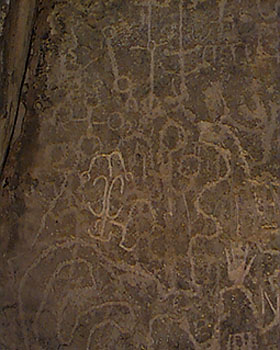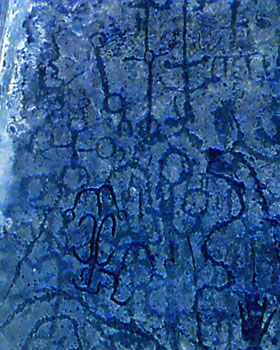
|
The Mystery of Ancient America's
ViewZone will attempt to give you all the details.
We are pleased with our discovery of a huge elk image in the rock art. But we are curious about some of the fainter petroglyphs that are behind the elk. A close-up of the area above the elk's hind quarters reveals an odd collection of circles, often connected to other circles by pecked lines. We also can see what appear to be tree-like shapes with arms or branches that terminate in these circles. Also, near to the top of these images, we can see compound symbols (a collection of symbols grouped together in one design) that incorporate the circle as part of the "trunk" of the tree.
  But we don't know that the Picket Wire people meant for these to be actual trees. Probably not. We have read that the elk was often a symbol for fertility in the Old World. Perhaps these circles can mean something like "life" or a "living thing" and then the tree concept can be viewed as the "family tree" and perhaps has significance in recording family lineage or births. This might also explain the "phi" symbols as meaning "death." What better symbol could signify the death of an animal than a slash through its symbol of life? We also note that, paradoxically, the human hand, appearing repeatedly on this wall, is a symbol for "bloody hands" or "death" in Martineau's interpretations. We see many hands on the bottom but they are all very small - much smaller and more realistic than the stylized hand in the antlers (lower right of picture). It seems as if they have been traced from actual hands. We have been told that the dwellings and artifacts of in the area suggest that, like the Anasazi, the people of these times were small. But some hand prints are even small for a three to four foot human and are obviously those of children. Most all are left hands. Where the hands can be seen clearly, they are male. Anthropologists tell us that in men, the ring finger is longer than the index finger. While in women this is reversed. Were the elk and the circles drawn in different eras? This is a question that will have to be answered on a return to this site with Polaroid's new PDC3000, a mega pixel camera that will allow us the resolution we need to extract this answer. In the meantime, we can only assume that the elk, whose hind quarters do not contain any circles, was incorporated into the mural with them. These pictures were taken with a 600 x 800 pixel camera. To complicate matters, there appear to be yet older and more crudely drawn circles pecked into the surface. Visible only as a pattern of pits and specks, when connected, they begin to form some of the oldest of these rock symbols. In short, we need to know much more. Your help and ideas are welcome.
|
